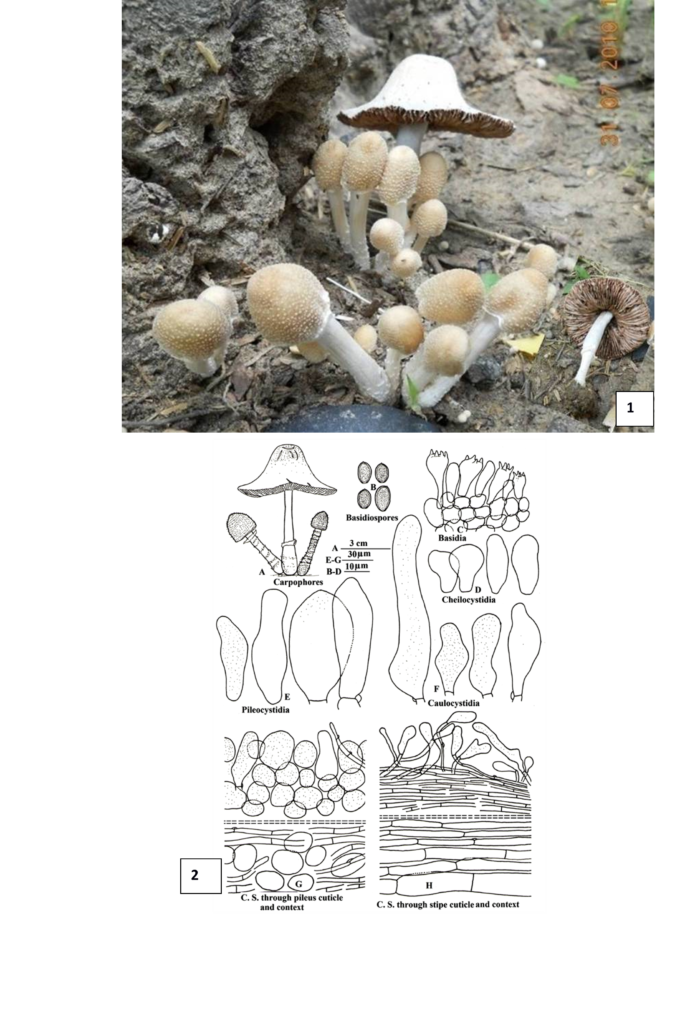Cyclocybe parasitica (G. Stev.) Vizzini
MycoBank number: MB 75045; Index Fungorum number: IF 75045; Facesoffungi Number: FoF 10426;
Cyclocybe parasitica (G. Stev.) Vizzini, Index Fungorum 154:1, 2014.
Synonym
Agrocybe parasitica G. Stev. New Zealand Journal of Forestry, 27 (1): 132, 1982
Description
lignicolous growing in caespitose clusters on and around trunk of living tree.
Sexual state: Carpophores 4.5–8 cm in height. Pileus 1.5–6 cm broad, campanulate; broadly umbonate; surface moist, greyish orange (5B3) when young, white at maturity, cracking in centre; scaly, scales powdery, white, cover the entire pileus; margin irregular, splitting at maturity; cuticle fully peeling; flesh 0.1–0.3 cm thick, membranous, white, unchanging; taste and odour mild. Pileal veil patchy, white. Lamellae adnate; unequal, in 3 lengths; lamellulae present; subdistant; moderately broad (0.5 cm broad); greyish brown (6D3), unchanging; gill edges lacerate; normal. Stipe central; 4.5–7.9 cm long, 0.4–0.8 cm broad, obclavate; white, unchanging; hollow; scaly, scales warty, scattered all over the stipe in young, maximum near the base in mature carpophores; annulate, annulus single, movable, superior in young carpophores, inferior in mature specimens, funnel shaped, membranous, attached. Basidiospores 6.76–8.45 (10.14) × 5.07–6.76 µm (excluding apiculus), (Q=1.6) ellipsoid; double walled; smooth, dark brown, granular; apex truncated with apical pore; apiculate, apiculus less than 0.84 µm long, inconspicuous. Basidia 11.83–20.26 × 5.07–8.45 µm, clavate, –4 spored, granular; sterigmata 2.5–3.38 µm long. Pleurocystidia not found. Cheilocystidia 16.9–23.66 × 8.45–13.52 µm, claviform, lageniform, thin walled, hyaline; gill edges sterile. Carpophore context homoiomerous. Pileus cuticle cellular, made up of 2–4 layers of spherical, granular cells interspersed with pileocystidia, individual elements measuring 15.76–39.4 × 15.76–31.52 µm. Pileocystidia 33.6–47.32 × 13.52–25.35 µm, lageniform, thin walled, weakly granular, few hyaline, some with clamp connection at the base, scattered, numerous; pileus context made up of intermingled hyphal and cellular elements. Hymenophoral trama regular. Stipe cuticle hyphal, made up of longitudinally tangled, compactly arranged, 3.94–7.88 µm broad, thickly granular hyphae, giving rise to a regular turf of projecting caulocystidia. Caulocystidia 27.04–47.32 (72.67) × 11.83–15.21 µm, lageniform, thin walled, granular, few hyaline, abundant, mostly with clamp connections at the base; stipe context 11.82–27.56 µm broad, septate, granular hyphae. Clamp connections present throughout. Asexual state: not observed, but see notes.
Material examined: INDIA, growing in caespitose clusters on and around trunk of living angiospermic tree, along roadside, 31 July 2010, Harwinder Kaur, PUN 5917,
Distribution: The above examined collection has been identified as Cyclocybe parasitica (G. Stev.) Vizzini. The presently worked out collection falls under Cyclocybe cylindracea group as in this group carpophores are always lignicolous and are growing on trunks of living trees, the pileus flesh is white, flesh taste is mild and the odour is pleasant, the stipe of the carpophores are annulate (Watling and Taylor, 1987). The macroscopic and microscopic details of this collection are in complete conformity with those given for C. parasitica by Watling and Taylor (1987). The presently examined collection has also been collected growing on and around trunk of living angiospermic trees as is the habitat given for C. parasitica by Watling and Taylor (1987). This is first time record for India.
Notes: The above examined collection has been identified as Cyclocybe parasitica (G. Stev.) Vizzini. The presently worked out collection falls under Cyclocybe cylindracea group as in this group carpophores are always lignicolous and are growing on trunks of living trees, the pileus flesh is white, flesh taste is mild and the odour is pleasant, the stipe of the carpophores are annulate (Watling and Taylor, 1987). The macroscopic and microscopic details of this collection are in complete conformity with those given for C. parasitica by Watling and Taylor (1987). The presently examined collection has also been collected growing on and around trunk of living angiospermic trees as is the habitat given for C. parasitica by Watling and Taylor (1987). This is first time record for India.
Consumption Habit: It is an excellent mushroom for eating and is very closely related to Cyclocybe cylindracea (Watling and Taylor, 1987). It is an edible mushroom with meaty savoury taste. It can be collected in the wild or cultivated on logs, it consists of 20% protein in dry mass, while the essential amino acid composition is similar to white button mushroom. Carbohydrate content is almost three times higher (Mitchell & Savage, 1990). It is known for culinary value, tawaka was historically used by Māori people as a traditional medicine. (https://eol.org/pages/46706311/articles#cite_ref-nzffa_3-0)

Fig. 1– 2 Cyclocybe parasitica (G. Stev.) Vizzini: 1 Carpophores growing in their natural habitat. 2 Camera Lucida drawings (A Carpophores. B Basidiospores. C Basidia. D Cheilocystidia. E Pileocystidia. F Caulocystidia. G C. S. through pileus cuticle & context. H C. S. through stipe cuticle & context).
